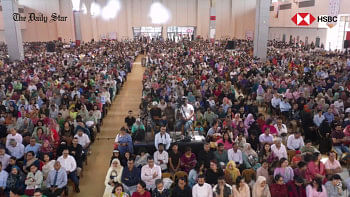Ila Mitra's 87th birth anniversary observed in Chapainawabganj
The 87th birth anniversary of the leader of Nachole Uprising, Ila Mitra, was observed with much fanfare at Shaheed Satu Hall in Chapainawabganj town on Friday.
Jago Nari Banhi Shikha, a local organisation of women, held a discussion, rally and cultural programme featuring traditional Santal dance.
Faruka Begum, local leader, presided over the discussion while Professor Mesbah Kamal of Dhaka University was present as chief guest.
Among others, Professor Sultana Razia, principal of Chapainawabganj Government College; Dr. Ummey Salma Abdullah; Monwara Khatun; and Rabindranath Saren, president of Jatiya Adivasi Parishad's central committee spoke at the discussion.
Ila Mitra was born in Kolkata on October 18, 1925. Her forefathers hailed from Bagotia of Jhenaidah. She began her political activities when she was a student at Bethun College in Kolkata.
In 1945, she married Ramendra Mitra, scion of the zamindar family of Chapainawabganj and an active member of Communist Party. She came to her husband's village home Krishnagobindapur in Chapainawabganj and became a teacher at the local girls' school. Later, Ila Mitra became a leader of the local peasantry in their movement. She played a key role in the Nachole Uprising and the Santal Rebellion between 1946 and 1950. Police arrested her in 1950 while she was trying to escape and tortured her. She was sentenced to life imprisonment.
In 1954, she fell very sick in jail. The government sent her on parole to Kolkata for treatment. To avoid arrest, she did not return home. She became involved in politics in Kolkata. She died in Kolkata on October 13, 2002.
The speakers also discussed the sacrifices and role of indigenous people who were involved during the Nachole Uprising and Santal Rebellion with Ila Mitra.
Speakers expressed the view that while the Nachole uprising and Santal Rebellion led by Ila Mitra were mass upsurges against tyranny, the lesson learnt are invaluable. The history of the movement teaches us the lesson of speaking out against any kind of repression, they said.
After the discussion, indigenous men and women performed their traditional dances and songs.
Earlier, a procession was brought out from Shaheed Satu Hall premises and paraded different roads in town. At least 300 people including indigenous men and women with different traditional musical instruments participated in the rally.

 For all latest news, follow The Daily Star's Google News channel.
For all latest news, follow The Daily Star's Google News channel. 



Comments